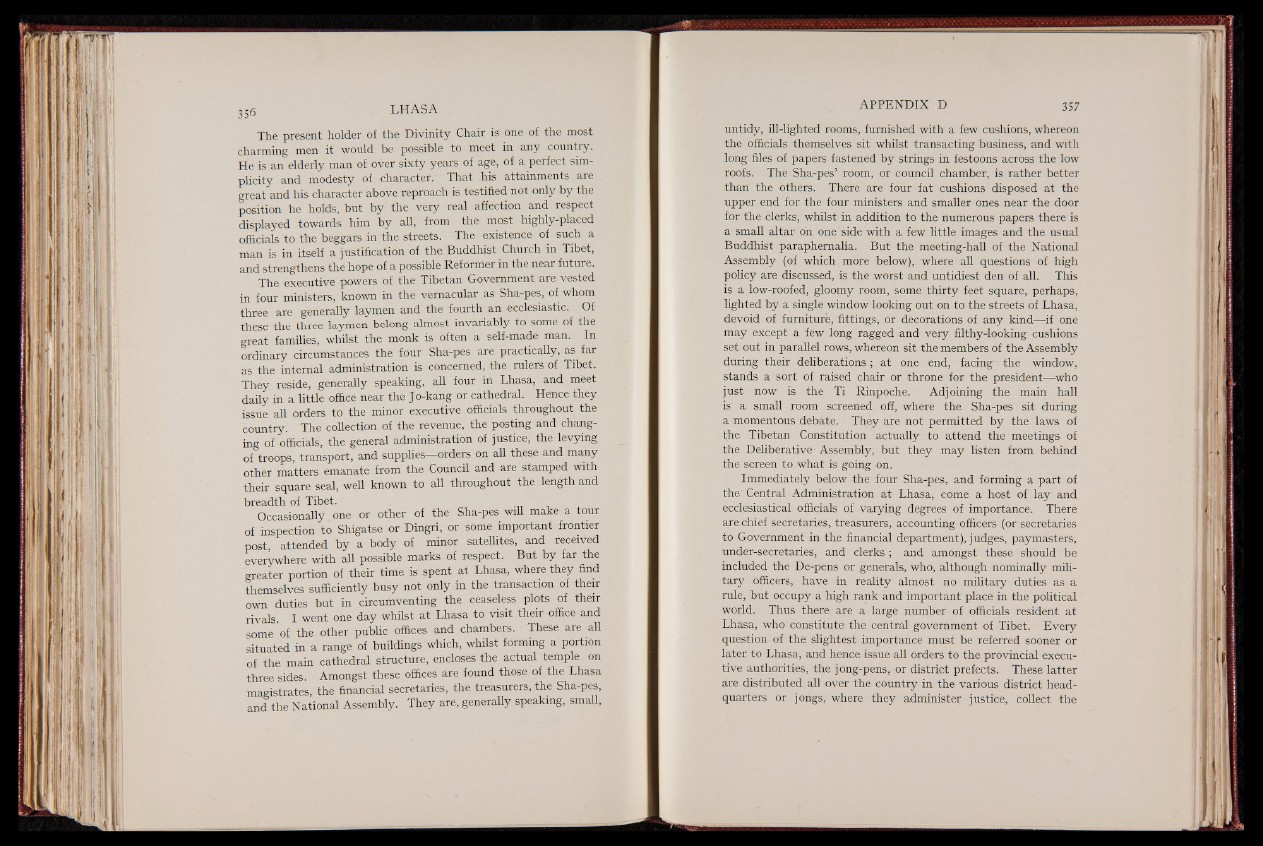
The present holder of the Divinity Chair is one of the most
charming men it would be possible to meet in any country.
He is an elderly man of over sixty years of age, of a perfect simplicity
and modesty of character. That his attainments are
great and his character above reproach is testified not only by the
position he holds, but by the very real affection and respect
displayed towards him by all, from the most highly-placed
officials to the beggars in the streets. The existence of such a
man is in itself a justification of the Buddhist Church in Tibet,
and strengthens the hope of a possible Reformer in the near future.
The executive powers of the Tibetan Government are vested
in four ministers, known in the vernacular as Sha-pes, of whom
three are generally laymen and the fourth an ecclesiastic. Of
these the three laymen belong almost invariably to some of the
great families, whilst the monk is often a, self-made man. In
ordinary circumstances the four Sha-pes are practically, as far
as the internal administration is concerned, the rulers of Tibet.
They reside, generally speaking, all four in Lhasa, and meet
daily in a little office near the J o-kang or cathedral. Hence they
issue all orders to the minor executive officials throughout the
country. The collection of the revenue, the posting and changing
of officials, the general administration of justice, the levying
of troops, transport, and supplies— orders on all these and many
other matters emanate from the Council and are stamped with
their square seal, well known to all throughout the length and
breadth of Tibet.
Occasionally one or other of the Sha-pes will make a tour
of inspection to Shigatse or Dingri, or some important frontier
post, attended by a body of minor satellites, and received
everywhere with all possible marks of respect. But by far the
greater portion of their time is spent at Lhasa, where they find
themselves sufficiently busy not only in the transaction of their
own duties but in circumventing the ceaseless plots of their
rivals I went one day whilst at Lhasa to visit their office and
some of the other public offices and chambers. These are all
situated in a range of buildings which, whilst forming a portion
of the main cathedral structure, encloses the actual temple on
three sides Amongst these offices are found those of the Lhasa
magistrates, the financial secretaries, the treasurers, the Sha-pes,
and the National Assembly. They are, generally speaking, small,
untidy, ill-lighted rooms, furnished with a few cushions, whereon
the officials themselves sit whilst transacting business, and with
long files of papers fastened by strings in festoons across the low
roofs. The Sha-pes’ room, or council chamber, is rather better
than the others. There are four fat cushions disposed at the
upper end for the four ministers and smaller ones near the door
for the clerks, whilst in addition to the numerous papers there is
a small altar on one side with a few little images and the usual
Buddhist paraphernalia. But the meeting-hall of the National
Assembly (of which more below), where all questions of high
policy are discussed, is the worst and untidiest den of all. This
is a low-roofed, gloomy room, some thirty feet square, perhaps,
lighted by a single window looking out on to the streets of Lhasa,
devoid of furniture, fittings, or decorations of any kind— if one
may except a few long ragged and very filthy-looking cushions
set out in parallel rows, whereon sit the members of the Assembly
during their deliberations; at one end, facing the window,
stands a sort of raised chair or throne for the president— who
just now is the Ti Rinpoche. Adjoining the main hall
is' a small room screened off, where the Sha-pes sit during
a momentous debate. They are not permitted by the laws of
the Tibetan Constitution actually to attend the meetings of
the Deliberative Assembly, but they may listen from behind
the screen to what is going on.
Immediately below the four Sha-pes, 'and forming a part of
the' Central Administration at Lhasa, come a host of lay and
ecclesiastical officials of varying degrees of importance. There
are chief secretaries, treasurers, accounting officers (or secretaries
to Government in the financial department), judges, paymasters,
under-secretaries, and clerks ; and amongst these should be
included the De-pens or generals, who, although nominally military
officers, have in reality almost no military duties as a
rule,, but occupy a high rank and important place in the political
world. Thus there are a large number of officials resident at
Lhasa, who constitute the central government of Tibet. Every
question of the slightest importance must be referred sooner or
later to Lhasa, and hence issue all orders to the provincial executive
authorities, the jong-pens, or district prefects. These latter
are distributed all over the country in the various district headquarters
or . jongs, where they administer justice, collect the